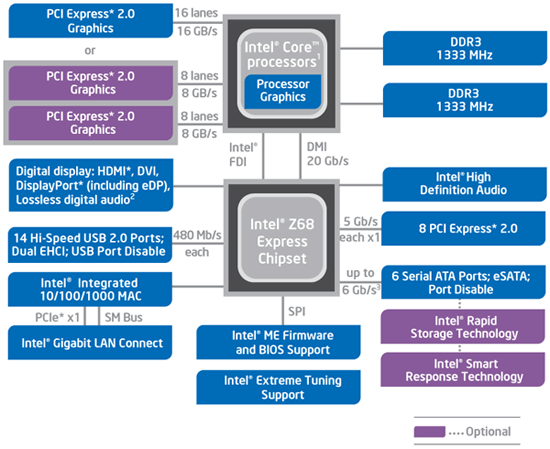Intel Z68 Express with Smart Response Technology
Introduction and Specifications
When Intel initially launched their second generation Core processor family, also known as Sandy Bridge, the processors were widely praised for their strong performance and power efficiency. Shortly thereafter, however, a defect in the processor’s companion 6-Series chipsets, which affected the reliability of some of its SATA ports, cropped up and forced Intel to halt production and recall the chipsets. A fix was relatively quick in the making and current chips based on the B3 revision of the silicon resolve the issue. However, the recall and subsequent lack of availability surely forced many consumers to pause before taking the plunge on a Sandy Bridge-based system.
Although the 6-series chipset bug isn’t the kind of thing that instills confidence in potential buyers, the delays caused by the recall may have ultimately benefitted many enthusiasts. How is this, you ask? Because today’s launch of the Z68 Express chipset erases a few of the shortcomings of the original members of the 6-series chipset family and makes a Sandy Bridge system all the more attractive.
If you recall back to the Sandy Bridge launch, we tested the two premiere chipsets in the 6-series, the enthusiast-targeted P67 and mainstream H67. Fundamentally, the two chipsets were very similar (and are based on the same piece of silicon), but each had a specific feature set designed for its target audience. For example, the P67 offered CPU and memory overclocking and increased power and current limits, while the H67 gave users the ability to take advantage of Sandy Bridge’s built-in graphics and Quick Sync media-encoding engine. P67 users that wanted to take advantage of Quick Sync and H67 users looking to do some CPU overclocking were simply out of luck. With the Z68 Express, however, prospective Sandy Bridge users no longer need to compromise.

To put it simply, Z68 Express is an amalgam of the P67 and H67 chipsets. The Z68 offers all of the features of both, in addition to a few new ones, so users wanting to get in on Quick Sync and some CPU overclocking will now have the platform to do so.
The high-level block diagram above gives a good visual representation of the Z68 Express chipset’s main features. Like the P67, the Z68 chipset is essentially an I/O hub, as all of the traditional Northbridge functionality has been integrated into the processor itself. As you can see, Sandy Bridge processors offer 16 lanes of PCI Express 2.0 connectivity on-die and they feature integrated dual-channel, DDR3 memory controllers. The processors are linked to the chipset via a 20Gb/s interface and the chipset itself is outfitted with 8 more PCIe 2.0 lanes, along with various other I/O, like USB 2.0 (14 ports), SATA (II and III), an integrated Gigabit MAC, digital display outputs, etc. Notably missing from the chipset is native USB 3.0 support, but that can be added using a discrete controller.
One new feature represented above is Intel’s Smart Response technology. Smart Response technology gives users the ability to configure a solid state drive as a dedicated cache for a companion hard drive. The technology works much like a hybrid hard drive like the Seagate Momentus XT; commonly accessed data is striped to the SSD so it can be accessed more quickly than it could be from the hard drive alone—more on that later though.

Also coming with the Z68 Express is broad industry adoption of LucidLogix’ Virtu GPU virtualization software. Most, if not all, motherboard vendors will be including Virtu with their Z68 Express based motherboards. What the software does is allow users to install a discrete GPU into their systems and still be able to take advantage of Quick Sync. Before Virtu came along, H67 users, for example, had to either connect monitors to both the Intel HD Graphics and discrete GPU, or switch the monitor from the discrete GPU to the Intel HD graphics output on a Sandy Bridge system to take advantage of Quick Sync. If there was no monitor connection present and a discrete card was plugged into a Sandy Bridge system, the integrated graphics core would be disabled, taking Quick Sync along with it. With Virtu, that is no longer the case.
We have covered LucidLogix’s Virtu in depth in this recent article. If you’d like more details on Virtu and its capabilities, we’d suggest checking that article out. Although we should point out Virtu has been updated a few times since our initial coverage and a handful of the issues mentioned in that piece have since been fixed.








